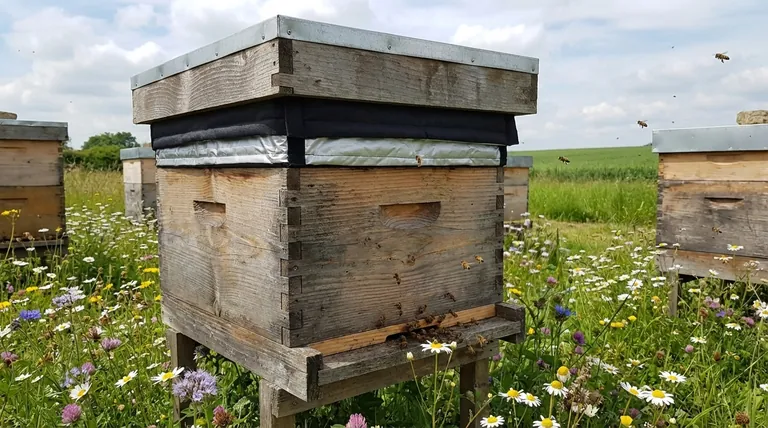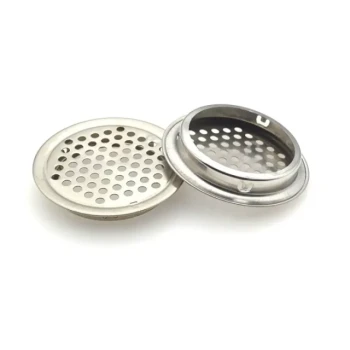The primary benefit of a telescoping outer cover is superior hive protection. Unlike simpler lids, its design features sides that hang down over the top edge of the hive body. This overhang acts as a crucial barrier, shielding the colony and the wooden components from rain, snow, and wind, making it an essential piece of equipment for long-term hive health, especially in harsh climates.
Choosing a telescoping outer cover is an investment in your hive's long-term health and structural integrity. Its design goes beyond simply covering the hive; it creates a weather-resistant seal that is critical for colonies in variable or challenging climates.

The Core Design Advantage: A Protective Overhang
A telescoping cover's key benefits stem directly from its signature design, where the lid fits over the hive rather than just on it.
Shielding from Precipitation
The overlapping sides prevent rain and melting snow from seeping into the top seams of the hive. This keeps the interior dry, which is critical for preventing mold and helping the colony regulate its temperature.
Protecting the Woodenware
This design doesn't just protect the bees; it protects your equipment. By shielding the top edges of the uppermost hive body from direct exposure, it dramatically reduces weathering and wood rot, extending the life of your investment.
Enhancing Durability with Metal Cladding
Most telescoping covers feature a galvanized metal top. This layer provides a durable, waterproof barrier that prevents the wood from degrading and leaking over time, ensuring the cover remains effective for many seasons.
Enhancing Hive Health and Climate Control
The protective exterior has a direct impact on the colony's internal environment, which is especially important during the stressful winter months.
Reducing Internal Condensation
A well-sealed, dry hive is easier for bees to manage. The telescoping cover works in tandem with an inner cover to create a system that helps manage moisture. By keeping external moisture out, it allows an upper entrance (often a notch in the inner cover) to ventilate the hive effectively, reducing harmful condensation buildup during winter.
Improving Natural Insulation
The space between the inner cover and the telescoping outer cover creates a pocket of trapped air. This air gap provides an additional layer of insulation, buffering the colony against extreme temperature swings in both winter and summer. For even greater effect, insulated models are also available.
Understanding the Trade-offs
While highly effective, the telescoping cover is not the only option, and it's important to understand its trade-offs compared to simpler, flat "migratory" lids.
Increased Cost
Telescoping covers are more complex to manufacture and use more materials. This makes them more expensive upfront than a basic migratory lid.
Weight and Handling
The robust construction and metal top make the telescoping cover heavier and slightly more cumbersome to remove during hive inspections. Beekeepers may find them more difficult to pry off if the bees have sealed the edges with propolis.
Not Ideal for Commercial Pollination
The flush-fitting design of migratory lids allows hives to be stacked tightly together on pallets for transport. The overhang of a telescoping cover makes this practice impossible, which is why they are less common in large-scale migratory beekeeping operations.
Making the Right Choice for Your Apiary
Your choice of cover should align directly with your climate, your beekeeping goals, and the level of investment you want to make in your equipment.
- If your primary focus is overwintering success in a cold or wet climate: The telescoping cover is the standard for a reason; its superior weather-sealing design is critical.
- If your primary focus is maximum durability and longevity: A telescoping cover with a galvanized metal top is the superior choice, as it actively protects your woodenware investment from the elements.
- If your primary focus is minimizing costs for a large number of hives in a mild climate: You might consider migratory lids, but acknowledge the reduced protection and potentially shorter lifespan of the equipment.
Ultimately, the telescoping cover provides an essential layer of security, allowing the colony to focus its energy on thriving rather than just surviving.
Summary Table:
| Benefit | Key Advantage |
|---|---|
| Superior Weather Protection | Overhanging sides shield hive from rain, snow, and wind. |
| Extended Equipment Life | Protects woodenware from rot and weathering. |
| Improved Hive Health | Reduces internal condensation and aids in temperature regulation. |
| Enhanced Insulation | Creates an air gap that buffers against extreme temperatures. |
| Durability | Metal-clad top provides a long-lasting, waterproof barrier. |
Ready to equip your apiary with durable, weather-proof telescoping covers?
At HONESTBEE, we specialize in supplying high-quality beekeeping supplies and equipment to commercial apiaries and distributors through our wholesale-focused operations. Investing in robust equipment like telescoping outer covers is crucial for protecting your colonies and your investment. Let us help you build a more resilient and productive operation.
Contact our wholesale team today to discuss your needs and get a quote.
Visual Guide

Related Products
- Professional Insulated Winter Hive Wrap for Beekeeping
- HONESTBEE Professional Long Handled Hive Tool with Precision Cutting Blade
- HONESTBEE Advanced Ergonomic Stainless Steel Hive Tool for Beekeeping
- Long Langstroth Style Horizontal Top Bar Hive for Wholesale
- Professional Drop-Style Hive Handles for Beekeeping
People Also Ask
- Why is it important to insulate beehives during winter? Boost Your Colony's Survival Rate
- What factors ensure bees stay warm and healthy during winter? Master the 3 Keys to Hive Survival
- Is it always necessary to insulate beehives? A Guide to Winter Survival & Colony Health
- What are the steps to properly wrap a beehive for winter? Ensure Your Colony Survives the Cold
- How does insulation help bee hives in severely cold weather? Conserve Energy & Ensure Colony Survival



















